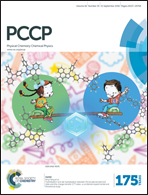Effects of the acceptor unit in dyes with acceptor–bridge–donor architecture on the electron photo-injection mechanism and aggregation in DSSCs†
Abstract
Dye-sensitized solar cells (DSSCs) are devices that convert light to electrical energy. Nowadays, researchers have focused on the understanding of the performance of dyes in solar cells. In this way, new efficient dyes have been obtained which can act as efficient light-harvesting compounds where the combination and the balance of acceptor(A)–bridge–donor(D) architectures confer suitable attributes and properties to the dye. Herein, we have carried out a DFT study on the optical and electronic properties of eight different A motifs and their influence on the electron photo-injection (PI) mechanisms through type I (indirect) or type II (direct) pathways in A–bridge–D dyes in DSSCs. The models consisted of thiophene as a bridge and triphenylamine as a D anchored to a TiO2 anatase cluster. All geometry optimizations were calculated using the B3LYP, CAM-B3LYP and BHandHLYP functionals combined with the 6-31G(d,p) basis set for C, H, N, O and S and the LANL2DZ pseudopotential for Ti atoms. Most of the A dyes display optoelectronic properties consistent with a type-I (indirect) mechanism except for the A5 dye where the results suggest a type-II (direct) PI pathway. In addition, molecular dynamics (MD) simulations have been carried out in order to describe the formation of dye dimers and analyze the stability of the aggregates due to intermolecular interactions. The observed trends indicate that dyes with A2 and A5 anchoring groups have less tendency to dimerize due to weaker intermolecular interactions resulting in less stable dimer complexes. Specifically, we found that the A motif influences the PI by a dye and the dimerization profiles.


 Please wait while we load your content...
Please wait while we load your content...